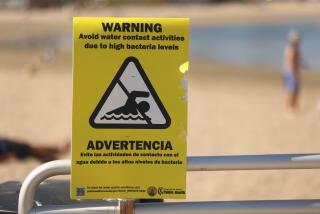Beach bacteria cause many illnesses but often aren’t blamed
- Share via
Many of America’s beaches are still contaminated by sewage water and are teeming with bacteria, but many sickened swimmers don’t realize they’ve caught a disease from the ocean.
That’s the rather filthy picture of America’s coastal areas from the Natural Resources Defense Council in its annual report on the state of the nation’s beaches – salty and otherwise. In 2010, the executive summary notes, the number of closures or warnings was the second highest in the 21 years the report has been issued.
Last year was particularly pathogenic in part because unusually heavy rains in some places carried contaminants into the ocean; the report points an especially accusatory finger at aging sewage systems. This Los Angeles Times story has more on the report, and the ratings for popular beaches can be found here.
But about that filthiness.
Infections linked to recreational water have risen in the past few decades, according to the Centers for Disease Control and Prevention. A pathogen of special concern is E. coli, which naturally flourishes in the gut and is found in sewage and fecal matter, because of its ability to cause gastrointestinal illnesses. But other pathogens can sicken swimmers as well. Beach water illnesses include so-called stomach flu, skin rashes, pinkeye, respiratory infections, meningitis and hepatitis. And children, who are less likely to think twice about submerging their heads and swallowing water, are particularly at risk.
Officials don’t have a specific number, or even a wide guess, of how many swimmers are sickened by contaminated ocean water each year. Most people treat the fever, diarrhea and vomiting without finding out the cause.
But just at Los Angeles County and Orange County beaches alone, the report says, one study estimates that 600,000 to 1.5 million gastrointestinal illnesses each year might be caused by fecal contamination. And in another study cited by the report, the chances of having a gastrointestinal illness at a Lake Michigan shore were twice as high for swimmers than nonswimmers.
Beach closings are often prompted by storm water and agricultural runoff, pollution from sewage and septic systems, and from wildlife, boat waste and other beachgoers. However, the pollution source goes unidentified half of the time, the report says.
The report calls for the Environmental Protection Agency to upgrade its water-monitoring systems for same-day results and for Congress to support legislation for infrastructure to reduce the volume of runoff to the oceans.
And it wouldn’t hurt to advise the little ones not to gulp beach water.
RELATED: More news from HealthKey
More to Read
Sign up for Essential California
The most important California stories and recommendations in your inbox every morning.
You may occasionally receive promotional content from the Los Angeles Times.










